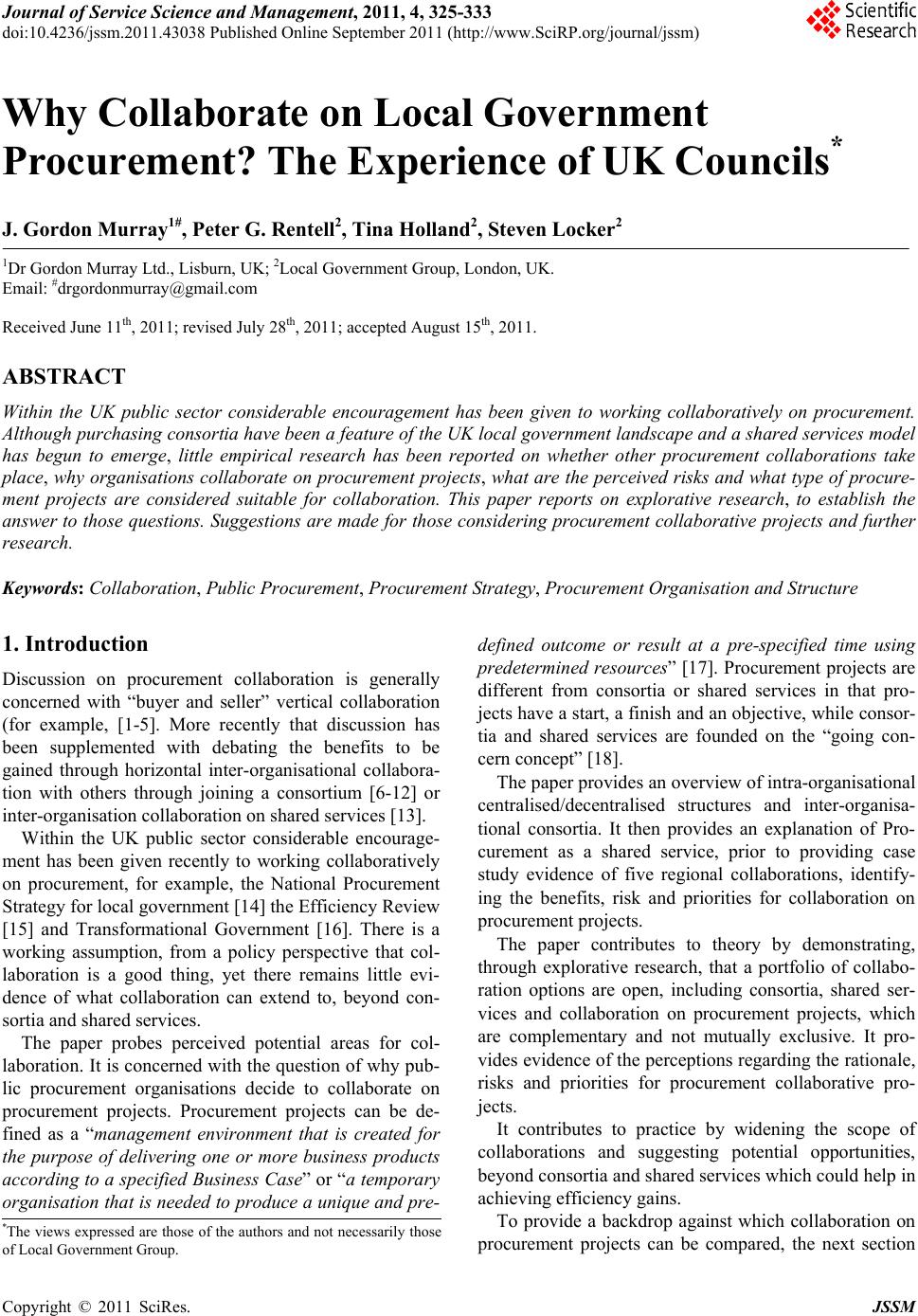 Journal of Service Science and Management, 2011, 4, 325-333 doi:10.4236/jssm.2011.43038 Published Online September 2011 (http://www.SciRP.org/journal/jssm) Copyright © 2011 SciRes. JSSM 325 Why Collaborate on Local Government Procurement? The Experience of UK Councils* J. Gordon Murray1#, Peter G. Rentell2, Tina Holland2, Steven Locker2 1Dr Gordon Murray Ltd., Lisburn, UK; 2Local Government Group, London, UK. Email: #drgordonmurray@gmail.com Received June 11th, 2011; revised July 28th, 2011; accepted August 15th, 2011. ABSTRACT Within the UK public sector considerable encouragement has been given to working collaboratively on procurement. Although purchasing consortia have been a feature of the UK local government landscape and a shared services model has begun to emerge, little empirical research has been reported on whether other procurement collaborations take place, why organisations collaborate on procurement projects, what are the perceived risks and what type of procure- ment projects are considered suitable for collaboration. This paper reports on explorative research, to establish the answer to those questions. Suggestions are made for those considering procurement collaborative projects and further research. Keywords: Collaboration, Public Procurement, Procurement Strategy, Procurement Organ i sation and Structure 1. Introduction Discussion on procurement collaboration is generally concerned with “buyer and seller” vertical collaboration (for example, [1-5]. More recently that discussion has been supplemented with debating the benefits to be gained through horizontal inter-organisational collabora- tion with others through joining a consortium [6-12] or inter-organisation collaboration on shared services [13]. Within the UK public sector considerable encourage- ment has been given recently to working collaboratively on procurement, for example, the National Procurement Strategy for local government [14] the Efficiency Review [15] and Transformational Government [16]. There is a working assumption, from a policy perspective that col- laboration is a good thing, yet there remains little evi- dence of what collaboration can extend to, beyond con- sortia and shared services. The paper probes perceived potential areas for col- laboration. It is concerned with the question of why pub- lic procurement organisations decide to collaborate on procurement projects. Procurement projects can be de- fined as a “management environment that is created for the purpose of delivering one or more business products according to a specified Business Case” or “a temporary organisation that is needed to produce a unique and pre- defined outcome or result at a pre-specified time using predetermined resources” [17]. Procurement projects are different from consortia or shared services in that pro- jects have a start, a finish and an objective, while consor- tia and shared services are founded on the “going con- cern concept” [18]. The paper provides an overview of intra-organisational centralised/decentralised structures and inter-organisa- tional consortia. It then provides an explanation of Pro- curement as a shared service, prior to providing case study evidence of five regional collaborations, identify- ing the benefits, risk and priorities for collaboration on procurement projects. The paper contributes to theory by demonstrating, through explorative research, that a portfolio of collabo- ration options are open, including consortia, shared ser- vices and collaboration on procurement projects, which are complementary and not mutually exclusive. It pro- vides evidence of the perceptions regarding the rationale, risks and priorities for procurement collaborative pro- jects. It contributes to practice by widening the scope of collaborations and suggesting potential opportunities, beyond consortia and shared services which could help in achieving efficiency gains. To provide a backdrop against which collaboration on procurement projects can be compared, the next section *The views expressed are those of the authors and not necessarily those of Local Government Group. 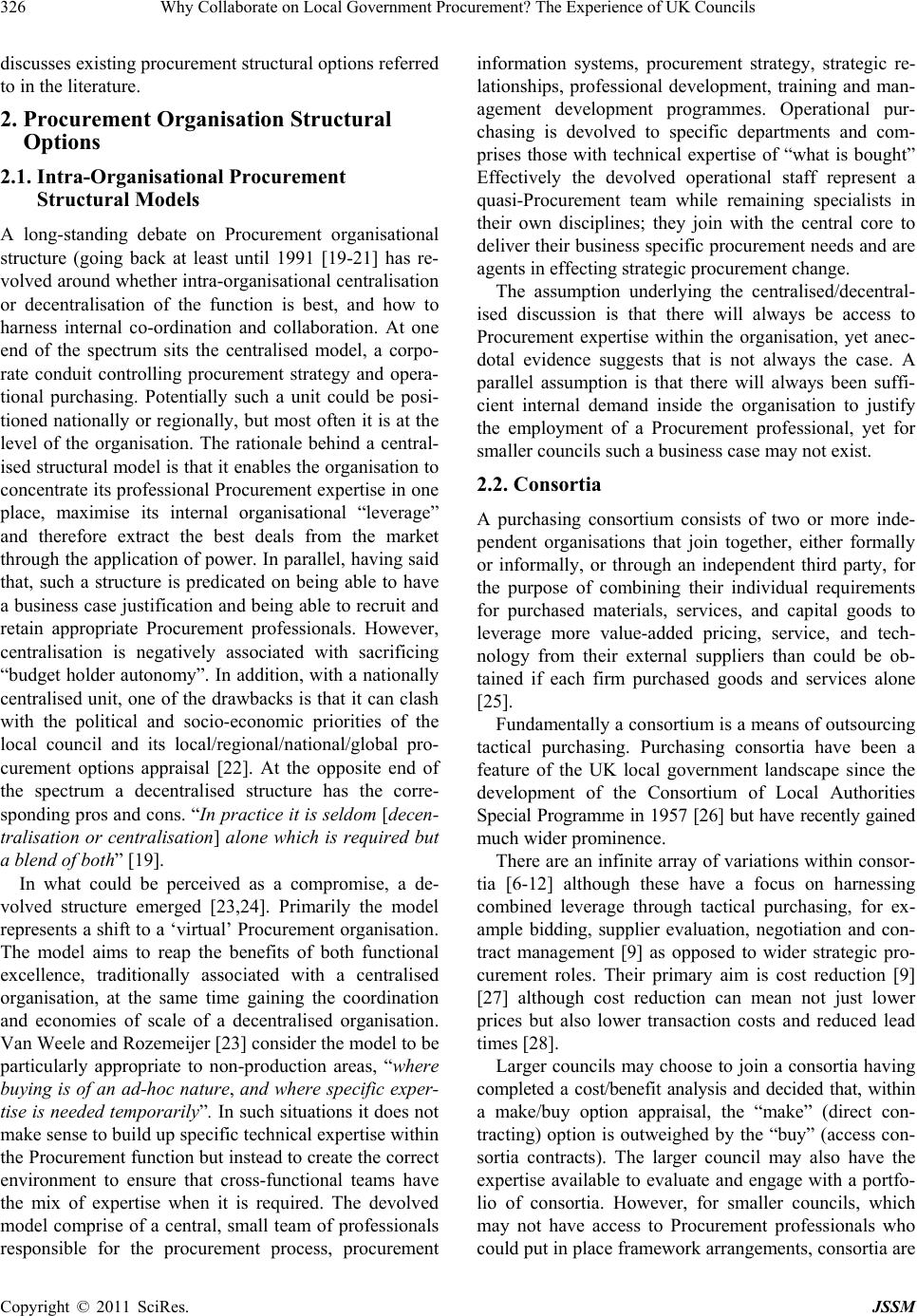 Why Collaborate on Local Government Procurement? The Experience of UK Councils 326 discusses existing procurement structural options referred to in the literature. 2. Procurement Organisation Structural Options 2.1. Intra-Organisational Procurement Structural Models A long-standing debate on Procurement organisational structure (going back at least until 1991 [19-21] has re- volved around whether intra-organisational centralisation or decentralisation of the function is best, and how to harness internal co-ordination and collaboration. At one end of the spectrum sits the centralised model, a corpo- rate conduit controlling procurement strategy and opera- tional purchasing. Potentially such a unit could be posi- tioned nationally or regionally, but most often it is at the level of the organisation. The rationale behind a central- ised structural model is that it enables the organisation to concentrate its professional Procurement expertise in one place, maximise its internal organisational “leverage” and therefore extract the best deals from the market through the application of power. In parallel, having said that, such a structure is predicated on being able to have a business case justification and being able to recruit and retain appropriate Procurement professionals. However, centralisation is negatively associated with sacrificing “budget holder autonomy”. In addition, with a nationally centralised unit, one of the drawbacks is that it can clash with the political and socio-economic priorities of the local council and its local/regional/national/global pro- curement options appraisal [22]. At the opposite end of the spectrum a decentralised structure has the corre- sponding pros and cons. “In practice it is seldom [decen- tralisation or centralisation] alone which is required but a blend of both” [19]. In what could be perceived as a compromise, a de- volved structure emerged [23,24]. Primarily the model represents a shift to a ‘virtual’ Procurement organisation. The model aims to reap the benefits of both functional excellence, traditionally associated with a centralised organisation, at the same time gaining the coordination and economies of scale of a decentralised organisation. Van Weele and Rozemeijer [23] consider the model to be particularly appropriate to non-production areas, “where buying is of an ad-hoc nature, and where specific exper- tise is needed temporarily”. In such situations it does not make sense to build up specific technical expertise within the Procurement function but instead to create the correct environment to ensure that cross-functional teams have the mix of expertise when it is required. The devolved model comprise of a central, small team of professionals responsible for the procurement process, procurement information systems, procurement strategy, strategic re- lationships, professional development, training and man- agement development programmes. Operational pur- chasing is devolved to specific departments and com- prises those with technical expertise of “what is bought” Effectively the devolved operational staff represent a quasi-Procurement team while remaining specialists in their own disciplines; they join with the central core to deliver their business specific procurement needs and are agents in effecting strategic procurement change. The assumption underlying the centralised/decentral- ised discussion is that there will always be access to Procurement expertise within the organisation, yet anec- dotal evidence suggests that is not always the case. A parallel assumption is that there will always been suffi- cient internal demand inside the organisation to justify the employment of a Procurement professional, yet for smaller councils such a business case may not exist. 2.2. Consortia A purchasing consortium consists of two or more inde- pendent organisations that join together, either formally or informally, or through an independent third party, for the purpose of combining their individual requirements for purchased materials, services, and capital goods to leverage more value-added pricing, service, and tech- nology from their external suppliers than could be ob- tained if each firm purchased goods and services alone [25]. Fundamentally a consortium is a means of outsourcing tactical purchasing. Purchasing consortia have been a feature of the UK local government landscape since the development of the Consortium of Local Authorities Special Programme in 1957 [26] but have recently gained much wider prominence. There are an infinite array of variations within consor- tia [6-12] although these have a focus on harnessing combined leverage through tactical purchasing, for ex- ample bidding, supplier evaluation, negotiation and con- tract management [9] as opposed to wider strategic pro- curement roles. Their primary aim is cost reduction [9] [27] although cost reduction can mean not just lower prices but also lower transaction costs and reduced lead times [28]. Larger councils may choose to join a consortia having completed a cost/benefit analysis and decided that, within a make/buy option appraisal, the “make” (direct con- tracting) option is outweighed by the “buy” (access con- sortia contracts). The larger council may also have the expertise available to evaluate and engage with a portfo- lio of consortia. However, for smaller councils, which may not have access to Procurement professionals who could put in place framework arrangements, consortia are Copyright © 2011 SciRes. JSSM 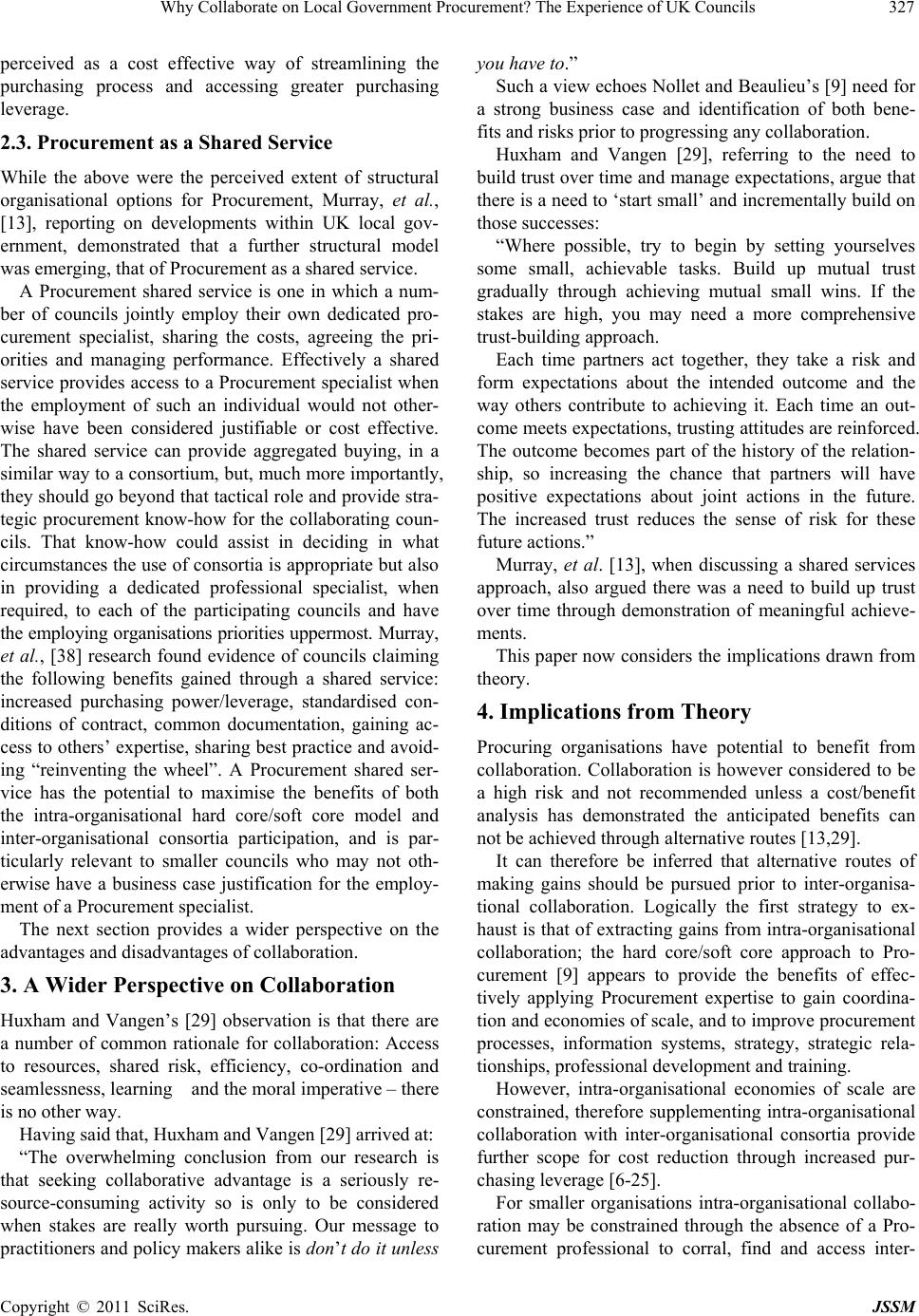 Why Collaborate on Local Government Procurement? The Experience of UK Councils327 perceived as a cost effective way of streamlining the purchasing process and accessing greater purchasing leverage. 2.3. Procurement as a Shared Service While the above were the perceived extent of structural organisational options for Procurement, Murray, et al., [13], reporting on developments within UK local gov- ernment, demonstrated that a further structural model was emerging, that of Procurement as a shared service. A Procurement shared service is one in which a num- ber of councils jointly employ their own dedicated pro- curement specialist, sharing the costs, agreeing the pri- orities and managing performance. Effectively a shared service provides access to a Procurement specialist when the employment of such an individual would not other- wise have been considered justifiable or cost effective. The shared service can provide aggregated buying, in a similar way to a consortium, but, much more importantly, they should go beyond that tactical role and provide stra- tegic procurement know-how for the collaborating coun- cils. That know-how could assist in deciding in what circumstances the use of consortia is appropriate but also in providing a dedicated professional specialist, when required, to each of the participating councils and have the employing organisations priorities uppermost. Murray, et al., [38] research found evidence of councils claiming the following benefits gained through a shared service: increased purchasing power/leverage, standardised con- ditions of contract, common documentation, gaining ac- cess to others’ expertise, sharing best practice and avoid- ing “reinventing the wheel”. A Procurement shared ser- vice has the potential to maximise the benefits of both the intra-organisational hard core/soft core model and inter-organisational consortia participation, and is par- ticularly relevant to smaller councils who may not oth- erwise have a business case justification for the employ- ment of a Procurement specialist. The next section provides a wider perspective on the advantages and disadvantages of collaboration. 3. A Wider Perspective on Collaboration Huxham and Vangen’s [29] observation is that there are a number of common rationale for collaboration: Access to resources, shared risk, efficiency, co-ordination and seamlessness, learning and the moral imperative – there is no other way. Having said that, Huxham and Vangen [29] arrived at: “The overwhelming conclusion from our research is that seeking collaborative advantage is a seriously re- source-consuming activity so is only to be considered when stakes are really worth pursuing. Our message to practitioners and policy makers alike is don’t do it unless you have to.” Such a view echoes Nollet and Beaulieu’s [9] need for a strong business case and identification of both bene- fits and risks prior to progressing any collaboration. Huxham and Vangen [29], referring to the need to build trust over time and manage expectations, argue that there is a need to ‘start small’ and incrementally build on those successes: “Where possible, try to begin by setting yourselves some small, achievable tasks. Build up mutual trust gradually through achieving mutual small wins. If the stakes are high, you may need a more comprehensive trust-building approach. Each time partners act together, they take a risk and form expectations about the intended outcome and the way others contribute to achieving it. Each time an out- come meets expectations, trusting attitudes are reinforced. The outcome becomes part of the history of the relation- ship, so increasing the chance that partners will have positive expectations about joint actions in the future. The increased trust reduces the sense of risk for these future actions.” Murray, et al. [13], when discussing a shared services approach, also argued there was a need to build up trust over time through demonstration of meaningful achieve- ments. This paper now considers the implications drawn from theory. 4. Implications from Theory Procuring organisations have potential to benefit from collaboration. Collaboration is however considered to be a high risk and not recommended unless a cost/benefit analysis has demonstrated the anticipated benefits can not be achieved through alternative routes [13,29]. It can therefore be inferred that alternative routes of making gains should be pursued prior to inter-organisa- tional collaboration. Logically the first strategy to ex- haust is that of extracting gains from intra-organisational collaboration; the hard core/soft core approach to Pro- curement [9] appears to provide the benefits of effec- tively applying Procurement expertise to gain coordina- tion and economies of scale, and to improve procurement processes, information systems, strategy, strategic rela- tionships, professional development and training. However, intra-organisational economies of scale are constrained, therefore supplementing intra-organisational collaboration with inter-organisational consortia provide further scope for cost reduction through increased pur- chasing leverage [6-25]. For smaller organisations intra-organisational collabo- ration may be constrained through the absence of a Pro- curement professional to corral, find and access inter- Copyright © 2011 SciRes. JSSM 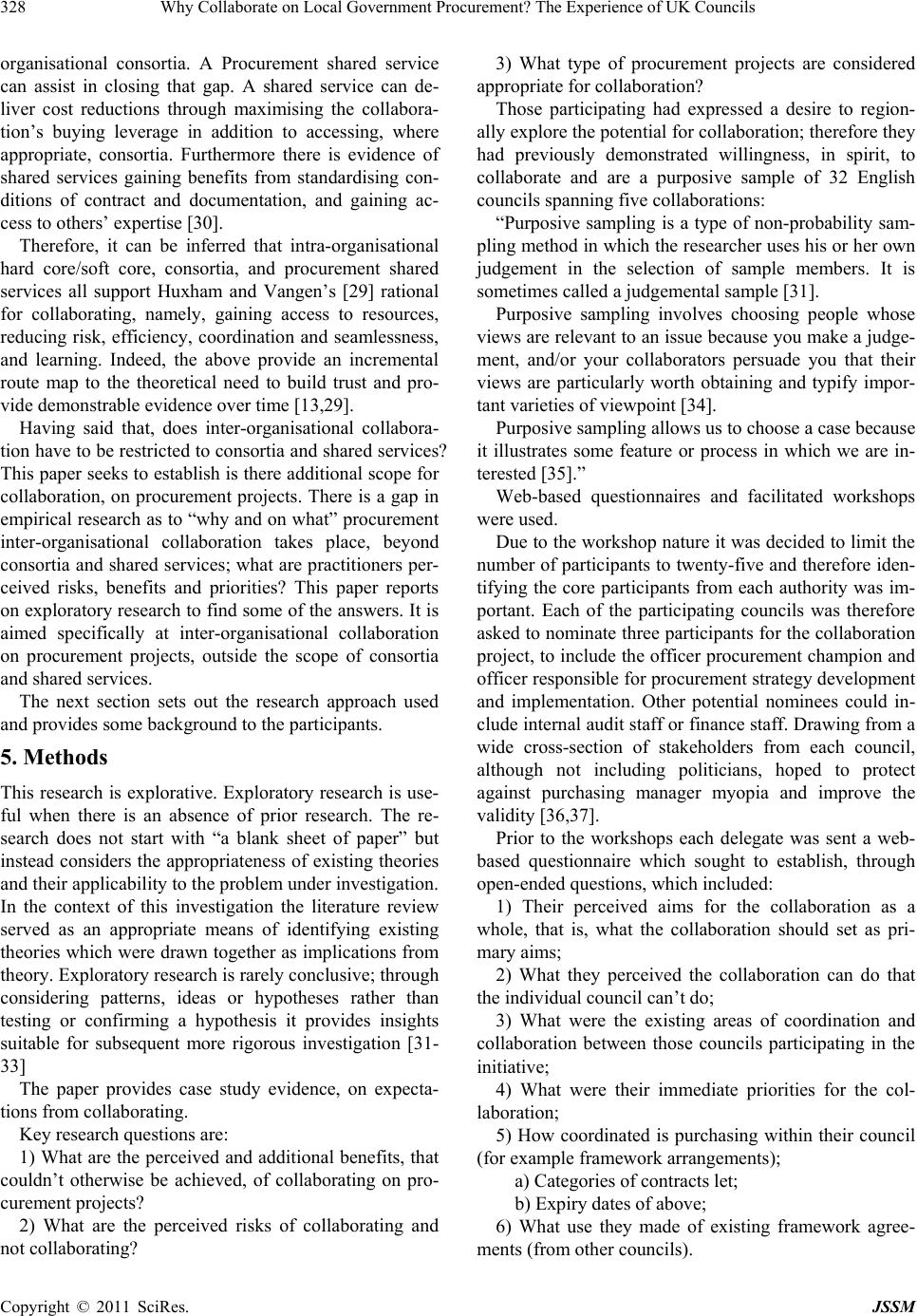 Why Collaborate on Local Government Procurement? The Experience of UK Councils 328 organisational consortia. A Procurement shared service can assist in closing that gap. A shared service can de- liver cost reductions through maximising the collabora- tion’s buying leverage in addition to accessing, where appropriate, consortia. Furthermore there is evidence of shared services gaining benefits from standardising con- ditions of contract and documentation, and gaining ac- cess to others’ expertise [30]. Therefore, it can be inferred that intra-organisational hard core/soft core, consortia, and procurement shared services all support Huxham and Vangen’s [29] rational for collaborating, namely, gaining access to resources, reducing risk, efficiency, coordination and seamlessness, and learning. Indeed, the above provide an incremental route map to the theoretical need to build trust and pro- vide demonstrable evidence over time [13,29]. Having said that, does inter-organisational collabora- tion have to be restricted to consortia and shared services? This paper seeks to establish is there additional scope for collaboration, on procurement projects. There is a gap in empirical research as to “why and on what” procurement inter-organisational collaboration takes place, beyond consortia and shared services; what are practitioners per- ceived risks, benefits and priorities? This paper reports on exploratory research to find some of the answers. It is aimed specifically at inter-organisational collaboration on procurement projects, outside the scope of consortia and shared services. The next section sets out the research approach used and provides some background to the participants. 5. Methods This research is explorative. Exploratory research is use- ful when there is an absence of prior research. The re- search does not start with “a blank sheet of paper” but instead considers the appropriateness of existing theories and their applicability to the problem under investigation. In the context of this investigation the literature review served as an appropriate means of identifying existing theories which were drawn together as implications from theory. Exploratory research is rarely conclusive; through considering patterns, ideas or hypotheses rather than testing or confirming a hypothesis it provides insights suitable for subsequent more rigorous investigation [31- 33] The paper provides case study evidence, on expecta- tions from collaborating. Key research questions are: 1) What are the perceived and additional benefits, that couldn’t otherwise be achieved, of collaborating on pro- curement projects? 2) What are the perceived risks of collaborating and not collaborating? 3) What type of procurement projects are considered appropriate for collaboration? Those participating had expressed a desire to region- ally explore the potential for collaboration; therefore they had previously demonstrated willingness, in spirit, to collaborate and are a purposive sample of 32 English councils spanning five collaborations: “Purposive sampling is a type of non-probability sam- pling method in which the researcher uses his or her own judgement in the selection of sample members. It is sometimes called a judgemental sample [31]. Purposive sampling involves choosing people whose views are relevant to an issue because you make a judge- ment, and/or your collaborators persuade you that their views are particularly worth obtaining and typify impor- tant varieties of viewpoint [34]. Purposive sampling allows us to choose a case because it illustrates some feature or process in which we are in- terested [35].” Web-based questionnaires and facilitated workshops were used. Due to the workshop nature it was decided to limit the number of participants to twenty-five and therefore iden- tifying the core participants from each authority was im- portant. Each of the participating councils was therefore asked to nominate three participants for the collaboration project, to include the officer procurement champion and officer responsible for procurement strategy development and implementation. Other potential nominees could in- clude internal audit staff or finance staff. Drawing from a wide cross-section of stakeholders from each council, although not including politicians, hoped to protect against purchasing manager myopia and improve the validity [36,37]. Prior to the workshops each delegate was sent a web- based questionnaire which sought to establish, through open-ended questions, which included: 1) Their perceived aims for the collaboration as a whole, that is, what the collaboration should set as pri- mary aims; 2) What they perceived the collaboration can do that the individual council can’t do; 3) What were the existing areas of coordination and collaboration between those councils participating in the initiative; 4) What were their immediate priorities for the col- laboration; 5) How coordinated is purchasing within their council (for example framework arrangements); a) Categories of contracts let; b) Expiry dates of above; 6) What use they made of existing framework agree- ments (from other councils). Copyright © 2011 SciRes. JSSM  Why Collaborate on Local Government Procurement? The Experience of UK Councils329 The responses from the questionnaires enabled each discrete workshop to be tailored by the individual par- ticipants’ views, which may not have been expressed in an open forum. At the workshop, following an introduction to col- laboration, summary feedback was provided from the pre-workshop questionnaires on participants’ collabora- tion aims. Those prompts were then used by workshop groups to reach agreement, but not necessarily consensus, on aims, priorities and timescales for inter-organisational collaboration. The outputs were analysed utilising “pattern matching” [38] against the pre-determined research questions. The unit of analysis regarding “benefits” is the indi- vidual council, while for “risks’” and “priorities” the unit of analysis is each of the five collaborations. The research is explorative and therefore generalisa- tions beyond those collaborations reported should be made, only with caution. 6. The Cases The cases represent a diverse mix, spend, geographically, size and type of councils. However, each of the collabo- rations had some previous experience of collaborating and therefore, it can be assumed, built up some trust. Of those councils participating in the research, 46% were districts; 55% had a corporate procurement unit led by a professional head of procurement –45% didn’t or didn’t know; 94% had a corporate procurement strategy and 73% had procurement strategies which set out their approach to collaboration; 79%, at that time, had been collaborating with other councils; 90% made use of con- sortia and 77% made use of public sector frameworks arrangements. 6.1. Collaboration A Collaboration A was between nine councils. Two of the districts had previously opted to deliver Procurement as a shared-service and participated in Murray, et al’s. [13] research. Prior to this research there had been previous examples of collaboration, although that had generally been between two or three councils. Examples of previ- ous collaborations included a joint P2P system. The ma- jority of those in the collaboration made use of consortia and other public sector framework arrangements. A re- gional procurement officer group met regularly. 6.2. Collaboration B Collaboration B was between three councils. All three of the councils had a history of collaboration with each other, for example, they jointly procured a spend analysis and, at the time of the investigation, were working on a joint telecommunications strategy. Two of the councils make use of an e-marketplace. 6.3. Collaboration C Collaboration C comprised five councils. Those partici- pating were a sub-group of a wider procurement officer network, comprising county and district councils, police, fire and NHS bodies. 6.4. Collaboration D Collaboration D comprised ten councils. All of the coun- cils had a long history of working collaboratively. Unlike the other cases, this collaboration participated in the pro- ject with a pre-defined e-procurement collaborative ob- jective project in mind. 6.5. Collaboration E Collaboration E comprised five councils. Four of the five councils use the same core financials platform. 7. Findings 7.1. Perceived Benefits of Participating in Collaboration and Added Value through Collaborating. The responses generally echoed the rationale put forward by Huxham and Vangen [29] for collaboration, namely, access to resources, efficiency, coordination and seam- lessness, and learning. While none of the participants identified sharing best practice as a perceived benefit, 25% recognised that as something which in the absence of collaboration would not otherwise be achieved. Other significant findings were the comparatively close corre- lation between perceived benefits and unique collabora- tion benefits gained on shared back office cost reductions and, standardisation of contract and specifications. This would suggest that the participants felt that they had reached a ceiling of what improvement that could be achieved elsewhere. 55% of the participant organisations had a Procurement Unit led by a Procurement profes- sional but only 9% of the participants felt the only way of gaining access to experience and capability lay in col- laboration; the assumption is made that 16% of those who envisaged this as a collaborative benefit had identi- fied other potential options. It may also be relevant that since 90% of the participants already made use of con- sortia and 77% made use of other public sector frame- work arrangements. Surprisingly none of the participants identified shared risk as a benefit. However, what does appear to have been presented is at least a business case rationale for collaborating on procurement projects which goes some way to satisfying Huxham and Vangen [29] and, Nollet and Beaulieu [9] Copyright © 2011 SciRes. JSSM 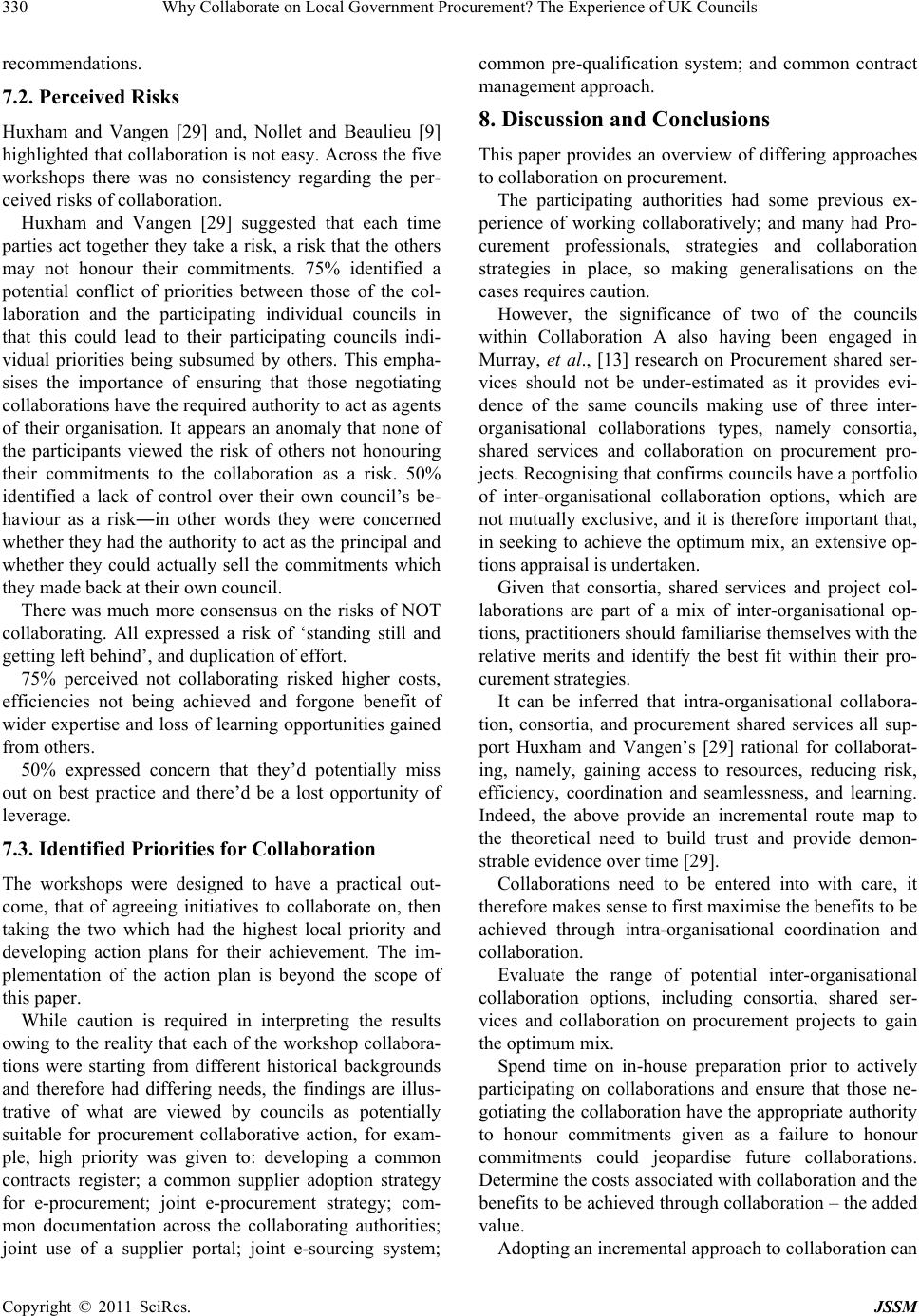 Why Collaborate on Local Government Procurement? The Experience of UK Councils 330 recommendations. 7.2. Perceived Risks Huxham and Vangen [29] and, Nollet and Beaulieu [9] highlighted that collaboration is not easy. Across the five workshops there was no consistency regarding the per- ceived risks of collaboration. Huxham and Vangen [29] suggested that each time parties act together they take a risk, a risk that the others may not honour their commitments. 75% identified a potential conflict of priorities between those of the col- laboration and the participating individual councils in that this could lead to their participating councils indi- vidual priorities being subsumed by others. This empha- sises the importance of ensuring that those negotiating collaborations have the required authority to act as agents of their organisation. It appears an anomaly that none of the participants viewed the risk of others not honouring their commitments to the collaboration as a risk. 50% identified a lack of control over their own council’s be- haviour as a risk―in other words they were concerned whether they had the authority to act as the principal and whether they could actually sell the commitments which they made back at their own council. There was much more consensus on the risks of NOT collaborating. All expressed a risk of ‘standing still and getting left behind’, and duplication of effort. 75% perceived not collaborating risked higher costs, efficiencies not being achieved and forgone benefit of wider expertise and loss of learning opportunities gained from others. 50% expressed concern that they’d potentially miss out on best practice and there’d be a lost opportunity of leverage. 7.3. Identified Priorities for Collaboration The workshops were designed to have a practical out- come, that of agreeing initiatives to collaborate on, then taking the two which had the highest local priority and developing action plans for their achievement. The im- plementation of the action plan is beyond the scope of this paper. While caution is required in interpreting the results owing to the reality that each of the workshop collabora- tions were starting from different historical backgrounds and therefore had differing needs, the findings are illus- trative of what are viewed by councils as potentially suitable for procurement collaborative action, for exam- ple, high priority was given to: developing a common contracts register; a common supplier adoption strategy for e-procurement; joint e-procurement strategy; com- mon documentation across the collaborating authorities; joint use of a supplier portal; joint e-sourcing system; common pre-qualification system; and common contract management approach. 8. Discussion and Conclusions This paper provides an overview of differing approaches to collaboration on procurement. The participating authorities had some previous ex- perience of working collaboratively; and many had Pro- curement professionals, strategies and collaboration strategies in place, so making generalisations on the cases requires caution. However, the significance of two of the councils within Collaboration A also having been engaged in Murray, et al., [13] research on Procurement shared ser- vices should not be under-estimated as it provides evi- dence of the same councils making use of three inter- organisational collaborations types, namely consortia, shared services and collaboration on procurement pro- jects. Recognising that confirms councils have a portfolio of inter-organisational collaboration options, which are not mutually exclusive, and it is therefore important that, in seeking to achieve the optimum mix, an extensive op- tions appraisal is undertaken. Given that consortia, shared services and project col- laborations are part of a mix of inter-organisational op- tions, practitioners should familiarise themselves with the relative merits and identify the best fit within their pro- curement strategies. It can be inferred that intra-organisational collabora- tion, consortia, and procurement shared services all sup- port Huxham and Vangen’s [29] rational for collaborat- ing, namely, gaining access to resources, reducing risk, efficiency, coordination and seamlessness, and learning. Indeed, the above provide an incremental route map to the theoretical need to build trust and provide demon- strable evidence over time [29]. Collaborations need to be entered into with care, it therefore makes sense to first maximise the benefits to be achieved through intra-organisational coordination and collaboration. Evaluate the range of potential inter-organisational collaboration options, including consortia, shared ser- vices and collaboration on procurement projects to gain the optimum mix. Spend time on in-house preparation prior to actively participating on collaborations and ensure that those ne- gotiating the collaboration have the appropriate authority to honour commitments given as a failure to honour commitments could jeopardise future collaborations. Determine the costs associated with collaboration and the benefits to be achieved through collaboration – the added value. Adopting an incremental approach to collaboration can Copyright © 2011 SciRes. JSSM 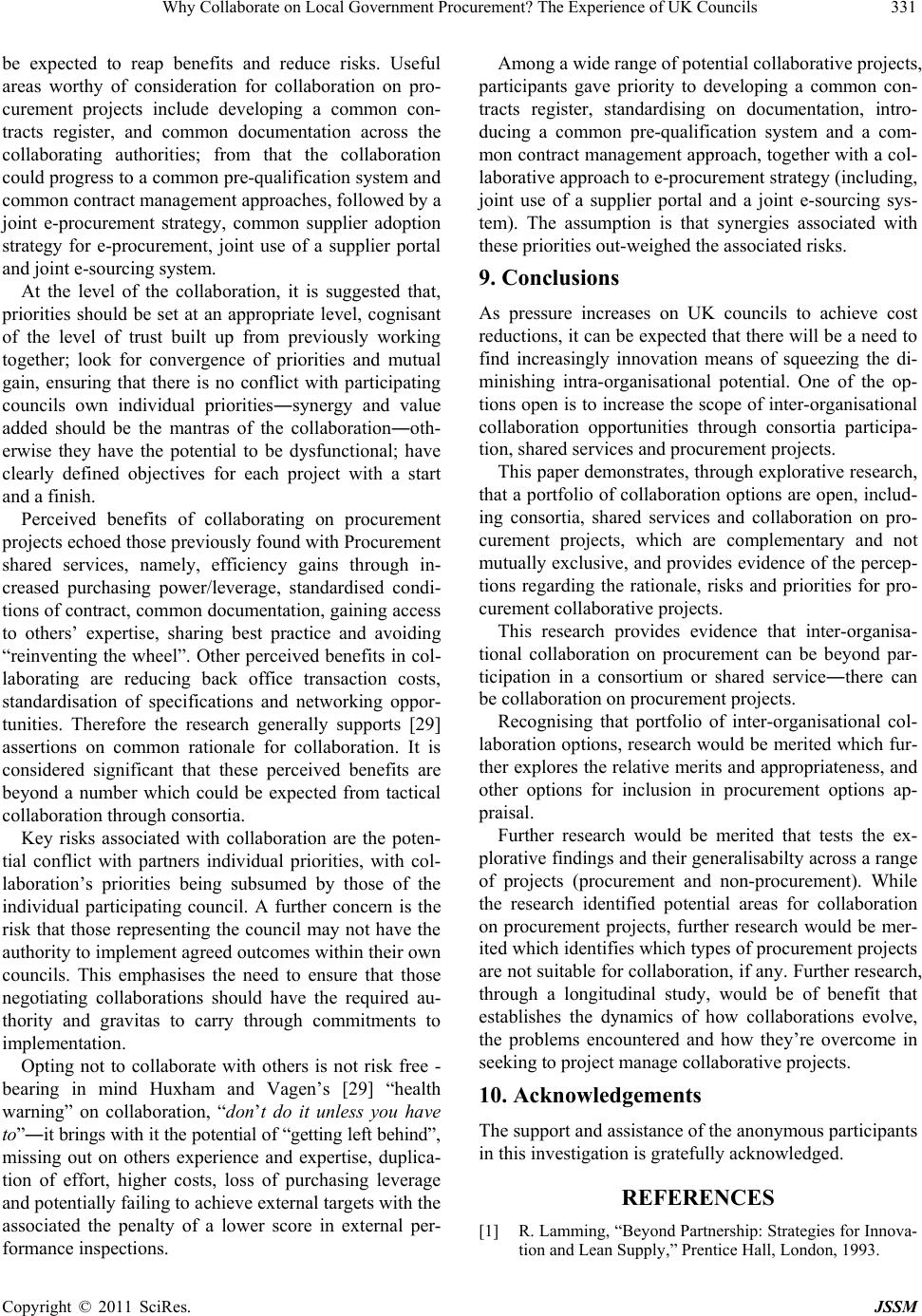 Why Collaborate on Local Government Procurement? The Experience of UK Councils331 be expected to reap benefits and reduce risks. Useful areas worthy of consideration for collaboration on pro- curement projects include developing a common con- tracts register, and common documentation across the collaborating authorities; from that the collaboration could progress to a common pre-qualification system and common contract management approaches, followed by a joint e-procurement strategy, common supplier adoption strategy for e-procurement, joint use of a supplier portal and joint e-sourcing system. At the level of the collaboration, it is suggested that, priorities should be set at an appropriate level, cognisant of the level of trust built up from previously working together; look for convergence of priorities and mutual gain, ensuring that there is no conflict with participating councils own individual priorities―synergy and value added should be the mantras of the collaboration―oth- erwise they have the potential to be dysfunctional; have clearly defined objectives for each project with a start and a finish. Perceived benefits of collaborating on procurement projects echoed those previously found with Procurement shared services, namely, efficiency gains through in- creased purchasing power/leverage, standardised condi- tions of contract, common documentation, gaining access to others’ expertise, sharing best practice and avoiding “reinventing the wheel”. Other perceived benefits in col- laborating are reducing back office transaction costs, standardisation of specifications and networking oppor- tunities. Therefore the research generally supports [29] assertions on common rationale for collaboration. It is considered significant that these perceived benefits are beyond a number which could be expected from tactical collaboration through consortia. Key risks associated with collaboration are the poten- tial conflict with partners individual priorities, with col- laboration’s priorities being subsumed by those of the individual participating council. A further concern is the risk that those representing the council may not have the authority to implement agreed outcomes within their own councils. This emphasises the need to ensure that those negotiating collaborations should have the required au- thority and gravitas to carry through commitments to implementation. Opting not to collaborate with others is not risk free - bearing in mind Huxham and Vagen’s [29] “health warning” on collaboration, “don’t do it unless you have to”―it brings with it the potential of “getting left behind”, missing out on others experience and expertise, duplica- tion of effort, higher costs, loss of purchasing leverage and potentially failing to achieve external targets with the associated the penalty of a lower score in external per- formance inspections. Among a wide range of potential collaborative projects, participants gave priority to developing a common con- tracts register, standardising on documentation, intro- ducing a common pre-qualification system and a com- mon contract management approach, together with a col- laborative approach to e-procurement strategy (including, joint use of a supplier portal and a joint e-sourcing sys- tem). The assumption is that synergies associated with these priorities out-weighed the associated risks. 9. Conclusions As pressure increases on UK councils to achieve cost reductions, it can be expected that there will be a need to find increasingly innovation means of squeezing the di- minishing intra-organisational potential. One of the op- tions open is to increase the scope of inter-organisational collaboration opportunities through consortia participa- tion, shared services and procurement projects. This paper demonstrates, through explorative research, that a portfolio of collaboration options are open, includ- ing consortia, shared services and collaboration on pro- curement projects, which are complementary and not mutually exclusive, and provides evidence of the percep- tions regarding the rationale, risks and priorities for pro- curement collaborative projects. This research provides evidence that inter-organisa- tional collaboration on procurement can be beyond par- ticipation in a consortium or shared service―there can be collaboration on procurement projects. Recognising that portfolio of inter-organisational col- laboration options, research would be merited which fur- ther explores the relative merits and appropriateness, and other options for inclusion in procurement options ap- praisal. Further research would be merited that tests the ex- plorative findings and their generalisabilty across a range of projects (procurement and non-procurement). While the research identified potential areas for collaboration on procurement projects, further research would be mer- ited which identifies which types of procurement projects are not suitable for collaboration, if any. Further research, through a longitudinal study, would be of benefit that establishes the dynamics of how collaborations evolve, the problems encountered and how they’re overcome in seeking to project manage collaborative projects. 10. Acknowledgements The support and assistance of the anonymous participants in this investigation is gratefully acknowledged. REFERENCES [1] R. Lamming, “Beyond Partnership: Strategies for Innova- tion and Lean Supply,” Prentice Hall, London, 1993. Copyright © 2011 SciRes. JSSM  Why Collaborate on Local Government Procurement? The Experience of UK Councils 332 [2] A. Erridge and J. G. Murray, “Lean Supply: A Strategy for Best Value in Local Government,” Public Policy and Administration, Vol. 13, No. 4, 1998, pp. 70-85. doi:10.1177/095207679801300206 [3] M. Barratt, “Understanding the Meaning of Collaboration in the Supply Chain,” Supply Chain Management: An In- ternational Journal, Vol. 9, No. 1, 2004, pp. 30-42. doi:10.1108/13598540410517566 [4] Y. Fu and R. Piplani, “Supply-Side Collaboration and Its Value in Supply Chains,” European Journal of Opera- tional Rese arch, Vol. 152, No. 1, 2004, pp. 281-288. doi:10.1016/S0377-2217(02)00670-7 [5] P. Cousins, “The Alignment of Appropriate Firm and Supply Strategies for Competitive Advantage,” Interna- tional Journal of Operations and Production Manage- ment, Vol. 25, No. 95, 2005, pp. 403-428. doi:10.1108/01443570510593120 [6] U. Arnold, “Purchasing Consortia as a Strategic Weapon for Highly Decentralised Multi-Divisional Companies: Finding from four case studies,” In: G. Capaldo, E. Es- poitio, C. lo Storo and M. Raffa, Eds., Supply Manage- ment, Ingegneria Economico-Gestionale, Italy, 1998, pp. 34-54. [7] M. Essig, “Purchasing Consortia as Symbiotic Relation- ships: Developing the Concept If ‘Consortium Sourc- ing’,” European Journal of Purchasing and Supply Man- agement, Vol. 6, No. 1, 2000, pp. 13-22. doi:10.1016/S0969-7012(99)00031-3 [8] F. Rozemeijer, “How to Manage Corporate Purchasing Synergy in a Decentralised Company? Towards Design Rules for Managing and Organising Purchasing Synergy in Decentralised Companies,” European Journal of Pur- chasing and Supply Management, Vol. 6, No. 1, 2000, pp. 5-12. doi:10.1016/S0969-7012(99)00034-9 [9] J. Nollet, and M. Beaulieu, “Should an Organisation Join a Purchasing Group?” Supply Chain Management: An In- ternational Journal, Vol. 10, No. 1, 2005, pp. 11-17. doi:10.1108/13598540510578333 [10] E. Bakker, H. Walker and C. Harland, “Organising for Collaborative Procurement: An initial conceptual frame- work,” In: G. Piga and K. V. Thai, Eds., Advancing Pub- lic Procurement: Practices, Innovation and Knowledge- sharing, PrAcdemics Press, Florida, 2006, pp. 14-44. [11] C. McCue and E. Prier, “Using Agency Theory to Model Cooperative Public Purchasing,” In: G. Piga and K. V. Thai, Eds., Advancing Public Procurement: Practices, Innovation and Knowledge-Sharing, PrAcdemics Press, Florida, 2006, pp. 45-70. [12] A. Vereecke and S. Muylle, “Performance Improvement through Supply Chain Collaboration in Europe,” Interna- tional Journal of Operations and Production Manage- ment, Vol. 26, No. 11, 2006, pp. 1176-1198. doi:10.1108/01443570610705818 [13] J. G. Murray, P. Rentell and D. Geere, “Procurement as a Shared Service in English Local Government,” Interna- tional Journal of Public Sector Management, Vol. 21, No. 5, 2008, pp. 540-555. doi:10.1108/09513550810885822 [14] ODPM/LGA (Office of the Deputy Prime Minister/Local Government Association) National Procurement Strategy for Local Government, ODPM, London, 2003. [15] P. Gershon, “Releasing Resources to the Front Line: An Independent Review of Public Sector Efficiency,” HM Treasury, London, 2004. [16] Cabinet Office, “Transformation Government: Enabled by Technology,” Cm 6683, 2005. [17] Office of Government Commerce, “Managing Successful Projects with PRINCE2,” TSO, London, 2002. [18] J. Sizer, “An Insight into Management Accounting,” Penguin Books, London, 1985. [19] IPS (Institute of Purchasing and Supply), “Purchasing: Role and Organisation,” Institute of Purchasing and Sup- ply, Stamford, 1991. [20] P. Baily, D. Farmer, J. Jessop and D. Jones, “Purchasing Principles and Management,” 7th Edition, Pitman, Lon- don, 1994. [21] A. J. van Weele, “Purchasing Management,” Chapman and Hall, London, 1994. [22] J. Hughes, M. Ralf and B. Michels, “Transform Your Supply Chain: Releasing Value in Business,” Interna- tional Thomson Business Press, London, 1998. [23] IPS (Institute of Purchasing and Supply), “Purchasing: Role and Organisation,” Institute of Purchasing and Sup- ply, Stamford, 1991. [24] A. J. van Weele, and F. Rosemijer, “Getting Organised for Purchasing and Supply Management in the Informa- tion Age; towards the Virtual Purchasing Organisation?” Proceedings of 2nd Worldwide Research Symposium in Purchasing and Supply Management, London, 1998, pp. 421-431. [25] R. Russill, “Purchasing Power: Your Suppliers, Your Profits,” McGraw Hill, London, 1997. [26] T. Hendrick, “Purchasing Consortiums: Horizontal Alli- ances among Firms Buying Common Goods and Services. What? Who? How?” Centre for Advanced Purchasing Studies, Tempe, 1997. [27] IMTA (Institute of Municipal Treasurers and Accountants) “Central Purchasing,” IMTA, London, 1963. [28] T. Kivisto, V.-M. Virolainen and E. Tella, “Consortia Purchasing and Logistics in the Kuopio Area,” In: L. Knight, C. Harland, J. Telgen, K. V. Thai, C. Callendar and H. McHen, Ed., Public Procurement: International case and Commentary, Routledge, London, 2007, pp. 190-201. [29] M. M. Aylesworth, “Consortia Purchasing for Higher Education in Canada, the US, the UK and Australia,” In: L. Knight, C. Harland, J. Telgen, K. V. Thai, C. Callendar and H. McHen, Ed., Public Procurement: International Case and Commentary, Routledge, London, 2007 pp. 176-189. [30] C. Huxham and S. Vangen, “Managing to Collaborate,” Rutledge, London, 2005. [31] E. Babbie “The Practice of Social Research,” 7th Edition, Copyright © 2011 SciRes. JSSM  Why Collaborate on Local Government Procurement? The Experience of UK Councils Copyright © 2011 SciRes. JSSM 333 Wadsworth, Belmont, 1995. [32] E. M. Phillips and D. S. Pugh, “How to Get a PhD: A Handbook for Students and Supervisors,” Open Univer- sity Press, Buckingham, 1994. [33] J. Hussey and R. Hussey, “Business Research,” Palgrave, London, 1997, [34] A. D. Jankowicz, “Business Research Projects,” 2nd Edi- tion, Chapman and Hall, London, 1995. [35] D. Silverman, “Doing Qualitative Research,” Sage, Lon- don, 2000. [36] A. Sayer, “Realism and Social Science,” Sage, London, 2000. [37] J. G. Murray, “Improving the Validity of Public Pro- curement Research,” International Journal of Public Sector Management, Vol. 22, No. 2, 2009, pp. 91-103. doi:10.1108/09513550910934501 [38] R. K. Yin, “Case Study Research,” Sage, London, 1994.
|